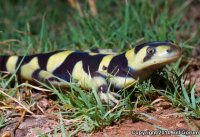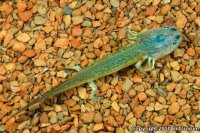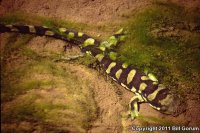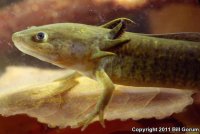Click on a picture to see a larger version in a different window
| Range: |
 |
| Other Names: |
|
| Description: |
Adult, terrestrial tiger salamanders grow to as much as 13.6 inches total length and 6.5 inches snout-vent length. They exhibit varying combinations of dorsal light and dark spots, bars, or reticulation. The barred tiger salamander (A. m. mavortium) has large, distinct yellowish bars or spots on a dark background. Larvae and gilled adults, called branchiates or neotenes, are aquatic, olive-gray, and possess three gills on each side of the head. Early in development, larval salamanders lack legs. |
| Habitat: |
Tiger salamanders breed in the still or sluggish waters of ponds, cattle tanks, backwaters, and lakes; often in open country. They breed in permanent or ephemeral wetlands, but the former often contain predators (e.g. fishes) that preclude or limit recruitment. When not breeding, terrestrial adults can be found in the uplands, often on roads at night during storms, sometimes as far as 2-3 miles from the breeding pond. Barred salamanders occur primarily in desert scrub and semi-desert grassland. |
| Behavior: |
Tiger salamanders have a complex life history that increases the likelihood of population persistence despite the dynamic nature of breeding habitats. During drought, ponds may not stay wet long enough to allow for metamorphosis of larvae, but terrestrial adults remain in the uplands to breed in subsequent years. In wet cycles, breeding will occur by both terrestrial and branchiate adults, and if environmental disaster strikes in the uplands, depleting numbers of terrestrial adults, reproduction by aquatic branchiates can still maintain the population. |
| Hibernation: |
|
| Reproduction: |
Breeding occurs from mid-winter into late spring; and rarely in late summer. Terrestrial adults typically return to their natal ponds to breed. Females lay 200-2,000 eggs individually or in small groups attached to sticks, aquatic vegetation, debris, or on the substrate. Eggs take 14-50 days to hatch, depending on water temperature. Larvae can metamorphose in as little as 2 months, but growth varies with a number of factors. The larval period is typically longer than 2 months, and some overwinter. |
| Diet: |
Larvae and branchiates feed on a wide variety of invertebrates. Cannabilistic morphs eat larger prey and may preferentially eat their own kind. Terrestrial adults feed on a variety of surface and subterranean invertebrates. Adults and large larvae will eat vertebrates, as well, including tadpoles, lizards, small snakes, and mice. |
Adapted from account at Reptilesofaz.com
Sources:

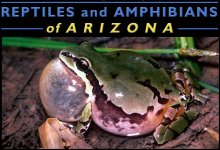
|


